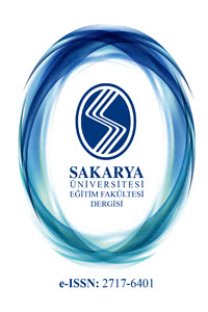EXPECTATIONS FROM THE UNIVERSITY AND FACULTY WEB-SITES IN ORIENTATION PERIOD
Bilgi ve iletişim teknolojileri bireylerin yaşam döngüsünü değiştirmesinin yanı sıra bireylerin alışveriş, bilgi arama, okuma yazma alışkanlıklarını da değiştirmektedir. İnternetin yaygınlaşması ile bilginin yayılma hızı katlanmakta ve bireyler bilgi arayışlarını internet üzerinden arayışa yoğunlaştırmışlardır. Üniversite, ilköğretim okulu, ortaöğretim okulu vb. eğitim veren kurumların web siteleri kurumların vizyonunu yansıtmakta ve geliştirilen web siteleri sayesinde kurumlar öğrencilere, öğretmenlere, akademisyenlere ve velilere hizmet sunmaktadırlar. Birçok öğrenci herhangi bir okulu tercih etmeden önce kuruma ait olan web sitesini incelemekte ve ilgili okula yerleştikten sonra da okulun sitesinde bilgilere ulaşmaya çalışmaktadırlar. Özellikle üniversite öğrencileri herhangi bir üniversiteye yerleştikten sonra üniversiteye ait web sitesine göz atmakta ve web sitesinden çeşitli bilgiler edinmeye çalışmaktadırlar. Bu bağlamda site üzerinde yer alan tanımlayıcı bilgiler öğrencilere büyük yardım sağlamakta ve bu tür bilgiler oryantasyon döneminde yer alan öğrencilerin fakülte ve üniversiteye aidiyet duygusunu pekiştirmektedir. Bu araştırmanın amacı üniversiteye yeni yerleşen öğretmen adaylarının üniversite ve fakülte web sitelerinden beklentilerini ve ne tür bilgileri aradıklarını belirlemektir.
Anahtar Kelimeler:
Oryantasyon, Üniversite Web Siteleri, Fakülte Web Siteleri
EXPECTATIONS FROM THE UNIVERSITY AND FACULTY WEB-SITES IN ORIENTATION PERIOD
The purpose of this research is to determine what the teacher candidates expect from the university and faculty web-sites who have recently been placed in the university and what kind of information they search. The research was figured as Phenomenological Research. The research was carried out with the teacher candidates who had recently been placed in a state university, in the first week of the commencement date of the education, using a semi-structured interview form. When the expectations of the teacher candidates from the university and faculty web-sites who enrolled in the university were analyzed, it was detected that students delivered opinions on the faculty photographs, information about the instructors, general information, university location, departments, announcements, course contents, postgraduate education opportunities and regulations. When the teacher candidates who have recently enrolled in the university, besides general visitors, are concerned, inclusion of the general information, in other words introductory information about university on the web-pages of the university and prominent design of the site in a manner to attract the visitors will facilitate the access of the visitors to such information.
Keywords:
Orientation University web-site, Faculty web-site, Teacher candidate,
___
- Akpınar, Y., & Bayramoğlu, Y. (2008). Promoting Teachers' Positive Attitude Towards Web Use: A Study in Web Site Development. Turkish Online Jounal of Educational Technology - TOJET , 7 (3), 46-55.
- Berglund, H. (2006). Researching entrepreneurship as lived experience. Eds: H. Neergaard, & J. P. Ulhøi, Handbook of qualitative research methods in entrepreneurship. USA.
- Ceyhan, E. (1995). Oryantasyon Eğitimi. Yaşadıkça Eğitim (42), 14-15.
- Daymon, C., & Holloway, I. (2002). Qualitative Research Methods in Public Relations and Marketing Communications. Routledge.
- Evans, M. (1998). Web Design: An Empiricist’s Guide. Seattle: University of Washington.
- Kutlu, M. (2004). Üniversite Öğrencilerinin Alıştırma-Oryantasyon Hizmetlerine İlişkin Karşılaştıkları Sorunlar ve Beklentileri. XIII. Ulusal Eğitim Bilimleri Kurultayı (s. 1-20). Malatya: İnönü Üniversitesi.
- Lichtman, M. (2006). Qualitative research in education: A user’s guide. USA: Sage Publications.
- LOU, S., SHIH, R., LIU, H., GUO, Y., & TSENG, K. (2010). The Influences of the Sixth Graders' Parents' Internet Literacy and Parenting Style on Internet Parenting. The Turkish Online Journal of Educational Technology - TOJET , 9 (4), 173-184.
- Meritt, J. (1996). Tour the Campus Without Leaving Home. Business Week , 157.
- Miller, S. G. (2000). Creating a Unified Web Site Design for the School of Technology at Purdue University. Society for Technical Communication. Virginia.
- Morrell, R. W., Dailey, S., Fieldman, C., Holt, B. J., Mayhorn, C., & Echt., K. (2001). Older Adults and Information Technology: A Compendium of Scientific Research and Web Site Accesibility Guidelines. Washington D.C.: National Institute of Aging.
- Nielsen, J., & Tahir, M. (2002). Homepage Usability: 50 Sites Deconstructed. Indianapolis: New Riders Publishing.
- Noel-Levitz. (2010). Focusing Your E-Recruitment Efforts to Meet the Expectations of College-Bound Students. Iowa: Noel-Levitz Inc. Patton, M. Q. (1990). Qualitative Research & Evaluation Methods.3rd Edition. USA: Sage Publications.
- Todres, L. (2005). Clarifying the life-world: Descriptive Phenomenology. Ed: I. Holloway, Qualitative Research in Health Care (s. 104-125). UK: Open University Press
- ISSN: 1303-0310
- Yayın Aralığı: Yılda 2 Sayı
- Başlangıç: 2001
- Yayıncı: Sakarya Üniversitesi
